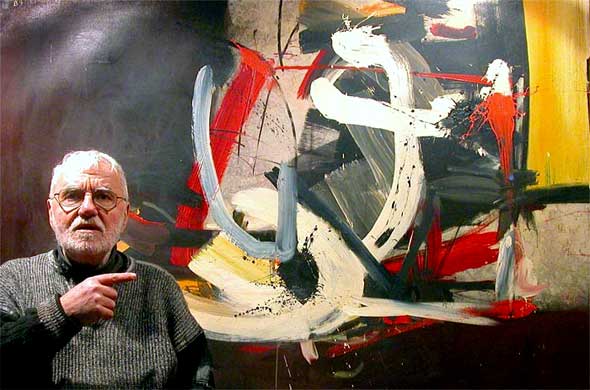
INTRODUCING
the artist
Despite being a highly celebrated artist, there are very rare opportunities of seeing his works displayed in Italy. As there is no current anthology about his life and works, this virtual art gallery represents “an extraordinary opportunity” to see the artist’s interesting visual poetry, as well as his style and favourite subjects.
"Danilo Picchiotti lives as he paints: moving away from external constraints, constantly searching for new ways to express his undefined and unaccomplished consciousness, endlessly seeking new empty spaces to dive in and finding unique expressions of true artistic freedom. His way of painting is passionate and impulsive: his works show the traces of sudden shifts, made out of instinct and without premeditation. He is possessed by a passion of instant creative freedom and by an artistic act originating from inside that bursts out abruptly before any meditation. By choosing to paint abstract art he expresses his desire to transcend limits, to overcome imposed rules and to go beyond dimensions and "always be nowhere and everywhere at the same time, and explore the core of things and all living beings". For his need of freedom Danilo Picchiotti cannot be classified into known groups or painting schools. Though he deeply knows and studies abstract art, he lives his creative experience alone".
Alberto Bistarelli
ART AND MATTER
in the works of Danilo Picchiotti.
“During Picchiotti’s artistic career, Informal Art, in all its poetic forms, is one of the most dominant artistic movements in the Western art scene. Among the fundamental topics of this vast cultural attitude there is the rejection of any kind of connection to the legacy of tradition and history. In 1952, the “militant” critic Michel Tapié claimed that the purpose of the “Art of Informel” was to develop an “art autre” or “art of another kind”, so that art is completely freed from its past.
In Picchiotti’s painting there is an eagerness to reconstruct, which is grounded on the need for new ethics, able to make up for the empty ideals of the late 19th century, that eventually led to a general sense of rejection and radical break with the past caused by the World Wars.
A faint, and often unclear, demarcation line is established between the matter and sign of Informal Art: some artists such as Jean Fautrier, Antoni Tápies, Jean Dubuffet, Alberto Burri will remaine mostly linked to Matter Painting.”
Jean Daniel Mura
INFORMAL ART AND
MATTER PAINTING
A variant of Informal Art often referred to as Matter Painting is the predominate art trend in Europe.
It derives from an ancient dichotomy first developed by Plato and then by other later philosophers: the Matter/Form polarity.
The former indicates the shapeless magma of raw, primitive energy, while the latter represents the matter structured into superior organisms.
This Matter-Form contrast became the main issue in Michelangelo’s sculptures and it will later influence modern sculpture through the “rediscovery” of Rodin.
Thanks to Informal Art even painters begin tackling the issue by presenting images, where aesthetic and expressive values are expressed by the materials they use. Matter Painting starts in the same year Pollock invented Action Painting: 1943.
The leading figure of this movement is the French painter Jean Furtrier, who is inspired by Picasso and Braque’s Synthetic Cubism and by Max Ernst’s surreal quests, and who incorporates his paintings with plastic materials emerging out of the canvas itself.
In this way he overcomes the boundary between two-dimensional images and plastic forms, generating art works that can no longer be classified as conventional forms of painting or sculpture.
European artists highlight the expressive values of the matter including, just to cite a few examples, the French Jean Dubuffet, the Spanish Antoni Tápies and the Italian Alberto Burri.
The latter, in particular, displays works with a remarkable expressive strength by using poor materials such as: pieces of burned woods, old jute bags, metal plates, plastic…
ABSTRACT ART AND
INFORMAL ART
The key issue in Abstractionism, and in all its different forms, is that it breaks away from the past and is basically an act of estrangement and alienation from the physical, changeable and phenomenal reality we live in. This, however, implies the willingness of the artists to relate to this reality, if only to reject it or distort its forms, according to a conscious research of a philosophical, and after all rational, explanation of the referential link between image and reality.
Particularly noteworthy is a book on Abstractionism written in 1908 by Wilhelm Worringer, one of the first authors to use this term. In his book “Abstraction and Empathy” he analyses the position of mankind in Nature, separating a sense of “einfuhlung” (empathy), i.e. a substantial balance, a spiritual communion between human beings and the real world, from a sense of rejection, anxiety and precariousness of the human condition (…)
World War II, an immense tragedy deeply affecting humanity’s historical and philosophical foundations, significantly influences the cultural landscapes of the time, and of art, in particular (…)
Informal Art imposes itself in this historical-cultural climate, breaking away from the past and radically rejecting any cultural links with the conventional notion of order, which founds itself completely devastated by the WWII; it finally establishes itself as the triumph of the irrational and denies the intellectual and spiritual foundations of Abstract Painting.
As usual, Informal Art has links and legacies from the past, which it also rejects, and takes its influence from recent European art movements, such as the Impressionism and subsequent styles, proving how the history of mankind, and similarly, the history of art, develops without continuity and that the present is always connected to the past:
it holds the emotional potential of Impressionism, the anticonformism of Dadaism, the aggressiveness of Expressionism and the mysticism of the Surrealism painting (…)
From “Abstract and Informal Art” by Vilma Torselli, 2002